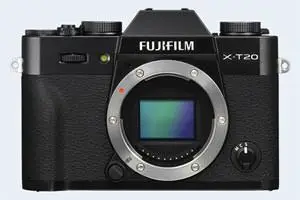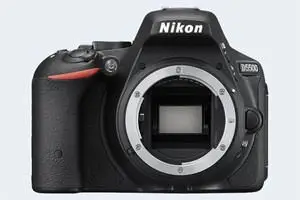Fujifilm X-T20 vs Nikon D5500
The Fujifilm X-T20 and the Nikon D5500 are two digital cameras that were revealed to the public, respectively, in January 2017 and January 2015. The X-T20 is a mirrorless interchangeable lens camera, while the D5500 is a DSLR. Both cameras are equipped with an APS-C sensor. Both cameras offer a resolution of 24 megapixels.
Below is an overview of the main specs of the two cameras as a starting point for the comparison.

Check X-T20 offers at
ebay.com

Check D5500 offers at
ebay.com
Going beyond this snapshot of core features and characteristics, what are the differences between the Fujifilm X-T20 and the Nikon D5500? Which one should you buy? Read on to find out how these two cameras compare with respect to their body size, their imaging sensors, their shooting features, their input-output connections, and their reception by expert reviewers.
Body comparison
The side-by-side display below illustrates the physical size and weight of the Fujifilm X-T20 and the Nikon D5500. The two cameras are presented according to their relative size. Three consecutive perspectives from the front, the top, and the back are available. All size dimensions are rounded to the nearest millimeter.
The X-T20 can be obtained in two different colors (black, silver), while the D5500 is also available in two color-versions, but different ones (black, red).
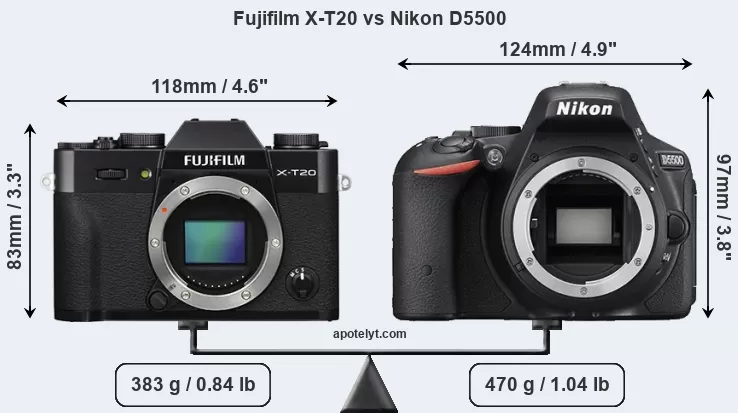

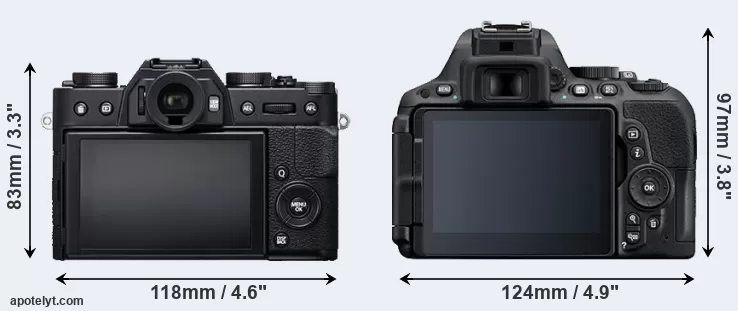
If the front view area (width x height) of the cameras is taken as an aggregate measure of their size, the Nikon D5500 is notably larger (23 percent) than the Fujifilm X-T20. Moreover, the D5500 is markedly heavier (23 percent) than the X-T20. In this context, it is worth noting that neither the X-T20 nor the D5500 are weather-sealed.
The above size and weight comparisons are to some extent incomplete since they do not consider the interchangeable lenses that both of these cameras require. Both cameras have similarly sized sensors, but DSLRs have a larger flange-to-focal plane distance than mirrorless cameras, which imposes contraints on the optical engineering process and generally leads to bigger and heavier lenses. You can compare the optics available for the two cameras in the Fujinon X Lens Catalog (X-T20) and the Nikon Lens Catalog (D5500). Mirrorless cameras, such as the Fujifilm X-T20, have moreover the advantage that they have a relatively short flange to focal plane distance and can thus use many lenses from other systems via adapters.
Concerning battery life, the X-T20 gets 350 shots out of its Fujifilm NP-W126S battery, while the D5500 can take 820 images on a single charge of its Nikon EN-EL14a power pack. The power pack in the X-T20 can be charged via the USB port, so that it is not always necessary to take the battery charger along when travelling.
The table below summarizes the key physical specs of the two cameras alongside a broader set of comparators. If you want to switch the focus of the display and review another camera pair, you can move across to the CAM-parator tool and choose from the broad selection of possible camera comparisons there.

| # | Camera Model |
Camera Width |
Camera Height |
Camera Depth |
Camera Weight |
Battery Life |
Weather Sealing |
Camera Launch |
Launch Price (USD) |
Street Price |
|
|---|---|---|---|---|---|---|---|---|---|---|---|
| 1. | Fujifilm X-T20 | 118 mm | 83 mm | 41 mm | 383 g | 350 | n | Jan 2017 | 899 | ebay.com | |
| 2. | Nikon D5500 | 124 mm | 97 mm | 70 mm | 470 g | 820 | n | Jan 2015 | 899 | ebay.com | |
| 3. | Canon M6 | 112 mm | 68 mm | 45 mm | 390 g | 295 | n | Feb 2017 | 779 | ebay.com | |
| 4. | Canon M5 | 116 mm | 89 mm | 61 mm | 427 g | 295 | n | Sep 2016 | 979 | ebay.com | |
| 5. | Fujifilm X-E4 | 121 mm | 73 mm | 33 mm | 364 g | 380 | n | Jan 2021 | 849 | amazon.com | |
| 6. | Fujifilm X-T30 II | 118 mm | 83 mm | 47 mm | 383 g | 380 | n | Sep 2021 | 899 | amazon.com | |
| 7. | Fujifilm X-T30 | 118 mm | 83 mm | 47 mm | 383 g | 380 | n | Feb 2019 | 899 | ebay.com | |
| 8. | Fujifilm X-A5 | 117 mm | 68 mm | 40 mm | 361 g | 450 | n | Jan 2018 | 399 | ebay.com | |
| 9. | Fujifilm X-T100 | 121 mm | 83 mm | 47 mm | 448 g | 430 | n | May 2018 | 599 | ebay.com | |
| 10. | Fujifilm X-E3 | 121 mm | 74 mm | 43 mm | 337 g | 350 | n | Sep 2017 | 899 | ebay.com | |
| 11. | Fujifilm X-A3 | 117 mm | 67 mm | 40 mm | 339 g | 410 | n | Aug 2016 | 399 | ebay.com | |
| 12. | Fujifilm X-T10 | 118 mm | 83 mm | 41 mm | 381 g | 350 | n | May 2015 | 799 | ebay.com | |
| 13. | Nikon D5600 | 124 mm | 97 mm | 70 mm | 465 g | 970 | n | Nov 2016 | 699 | ebay.com | |
| 14. | Nikon D3400 | 124 mm | 98 mm | 76 mm | 445 g | 1200 | n | Aug 2016 | 499 | ebay.com | |
| 15. | Nikon D3300 | 124 mm | 98 mm | 76 mm | 430 g | 700 | n | Jan 2014 | 499 | ebay.com | |
| 16. | Nikon D5300 | 125 mm | 98 mm | 76 mm | 480 g | 600 | n | Oct 2013 | 799 | ebay.com | |
| Note: Measurements and pricing do not include easily detachable parts, such as add-on or interchangeable lenses or optional viewfinders. | |||||||||||
Any camera decision will naturally be influenced heavily by the price. The retail prices at the time of the camera’s release place the model in the market relative to other models in the producer’s line-up and the competition. The two cameras under review were launched at the same price and fall into the same market segment. Normally, street prices remain initially close to the MSRP, but after a couple of months, the first discounts appear. Later in the product cycle and, in particular, when the replacement model is about to appear, further discounting and stock clearance sales often push the camera price considerably down. Then, after the new model is out, very good deals can frequently be found on the pre-owned market.
Sensor comparison
The size of the sensor inside a digital camera is one of the key determinants of image quality. A large sensor will generally have larger individual pixels that offer better low-light sensitivity, provide wider dynamic range, and have richer color-depth than smaller pixels in a sensor of the same technological generation. Moreover, a large sensor camera will give the photographer more control over depth-of-field in the image and, thus, the ability to better isolate a subject from the background. On the downside, larger sensors tend to be associated with larger, more expensive camera bodies and lenses.
Both cameras under consideration feature an APS-C sensor, but their sensors differ slightly in size. They nevertheless have the same format factor of 1.5. Both cameras have a native aspect ratio (sensor width to sensor height) of 3:2.
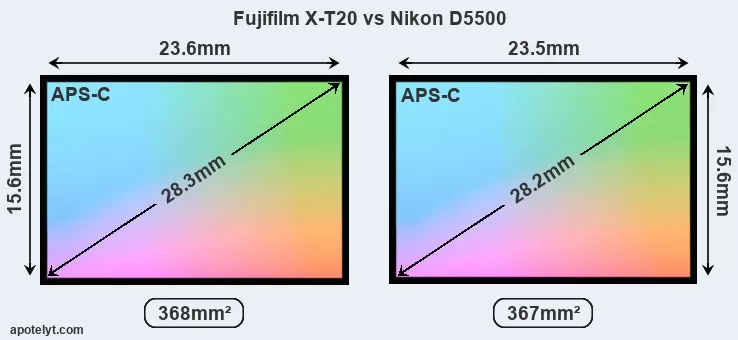
Even though the X-T20 has a slightly larger sensor, both cameras offer the same resolution of 24 megapixels. This implies that the X-T20 has a lower pixel density and larger individual pixels (with a pixel pitch of 3.92μm versus 3.91μm for the D5500), which gives it a potential advantage in terms of light gathering capacity. In addition, the X-T20 is much more recent (by 2 years) than the D5500, and its sensor will have benefitted from technological advances during this time. Coming back to sensor resolution, it should be mentioned that neither of the two cameras has an anti-alias filter installed, so they are able to capture all the detail the sensor resolves.
The X-T20 has on-sensor phase detect pixels, which results in fast and reliable autofocus acquisition even during live view operation.
The Fujifilm X-T20 has a native sensitivity range from ISO 200 to ISO 12800, which can be extended to ISO 100-51200. The corresponding ISO settings for the Nikon D5500 are ISO 100 to ISO 25600 (no boost).
Technology-wise, both cameras are equipped with CMOS (Complementary Metal–Oxide–Semiconductor) sensors. The X-T20 uses Fujifilm's X-Trans layout of photosites, while the D5500 employs the more common Bayer array.
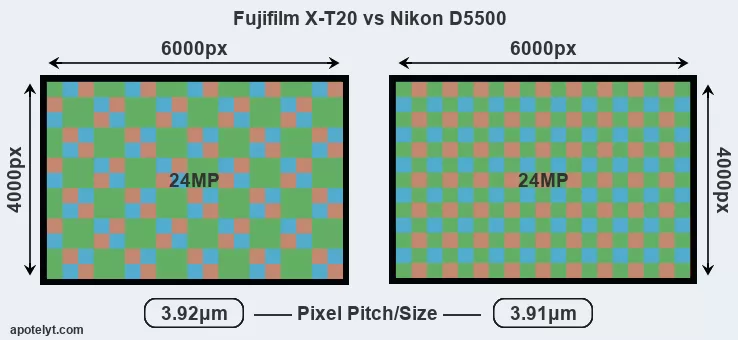
For many cameras, data on sensor performance has been reported by DXO Mark. This service is based on lab testing and assigns an overall score to each camera sensor, as well as ratings for dynamic range ("DXO Landscape"), color depth ("DXO Portrait"), and low-light sensitivity ("DXO Sports"). The following table provides an overview of the physical sensor characteristics, as well as the sensor quality measurements for a selection of comparators.

| # | Camera Model |
Sensor Class |
Resolution (MP) |
Horiz. Pixels |
Vert. Pixels |
Video Format |
DXO Portrait |
DXO Landscape |
DXO Sports |
DXO Overall |
|
|---|---|---|---|---|---|---|---|---|---|---|---|
| 1. | Fujifilm X-T20 | APS-C | 24.0 | 6000 | 4000 | 4K/30p | 23.9 | 13.2 | 1704 | 81 | |
| 2. | Nikon D5500 | APS-C | 24.0 | 6000 | 4000 | 1080/60p | 24.1 | 14.0 | 1438 | 84 | |
| 3. | Canon M6 | APS-C | 24.0 | 6000 | 4000 | 1080/60p | 23.4 | 12.6 | 1317 | 78 | |
| 4. | Canon M5 | APS-C | 24.0 | 6000 | 4000 | 1080/60p | 23.4 | 12.4 | 1262 | 77 | |
| 5. | Fujifilm X-E4 | APS-C | 26.0 | 6240 | 4160 | 4K/30p | 24.2 | 13.7 | 2085 | 85 | |
| 6. | Fujifilm X-T30 II | APS-C | 26.0 | 6240 | 4160 | 4K/30p | 24.2 | 13.8 | 2144 | 85 | |
| 7. | Fujifilm X-T30 | APS-C | 26.0 | 6240 | 4160 | 4K/30p | 24.1 | 13.5 | 1895 | 83 | |
| 8. | Fujifilm X-A5 | APS-C | 24.0 | 6000 | 4000 | 4K/15p | 24.0 | 13.3 | 1800 | 82 | |
| 9. | Fujifilm X-T100 | APS-C | 24.0 | 6000 | 4000 | 4K/15p | 24.0 | 13.4 | 1829 | 83 | |
| 10. | Fujifilm X-E3 | APS-C | 24.0 | 6000 | 4000 | 4K/30p | 23.9 | 13.3 | 1764 | 82 | |
| 11. | Fujifilm X-A3 | APS-C | 24.0 | 6000 | 4000 | 1080/60p | 23.8 | 13.1 | 1664 | 81 | |
| 12. | Fujifilm X-T10 | APS-C | 16.0 | 4896 | 3264 | 1080/60p | 23.7 | 12.9 | 1546 | 79 | |
| 13. | Nikon D5600 | APS-C | 24.0 | 6000 | 4000 | 1080/60p | 24.1 | 14.0 | 1306 | 84 | |
| 14. | Nikon D3400 | APS-C | 24.0 | 6000 | 4000 | 1080/60p | 24.8 | 13.9 | 1192 | 86 | |
| 15. | Nikon D3300 | APS-C | 24.0 | 6000 | 4000 | 1080/60p | 24.3 | 12.8 | 1385 | 82 | |
| 16. | Nikon D5300 | APS-C | 24.0 | 6000 | 4000 | 1080/60p | 24.0 | 13.9 | 1338 | 83 | |
| Note: DXO values in italics represent estimates based on sensor size and age. | |||||||||||
Many modern cameras are not only capable of taking still images, but also of capturing video footage. The two cameras under consideration both have sensors whose read-out speed is fast enough to capture moving pictures, but the X-T20 provides a higher video resolution than the D5500. It can shoot video footage at 4K/30p, while the Nikon is limited to 1080/60p.
Feature comparison
Apart from body and sensor, cameras can and do differ across a variety of features. For example, the X-T20 has an electronic viewfinder (2360k dots), while the D5500 has an optical one. Both systems have their advantages, with the electronic viewfinder making it possible to project supplementary shooting information into the framing view, whereas the optical viewfinder offers lag-free viewing and a very clear framing image. The viewfinder in the X-T20 offers a wider field of view (100%) than the one in the D5500 (95%), so that a larger proportion of the captured image is visible in the finder. In addition, the viewfinder of the X-T20 has a higher magnification (0.62x vs 0.57x), so that the size of the image transmitted appears closer to the size seen with the naked human eye. The table below summarizes some of the other core capabilities of the Fujifilm X-T20 and Nikon D5500 in connection with corresponding information for a sample of similar cameras.

| # | Camera Model |
Viewfinder (Type or 000 dots) |
Control Panel (yes/no) |
LCD Specifications (inch/000 dots) |
LCD Attach- ment |
Touch Screen (yes/no) |
Max Shutter Speed * |
Max Shutter Flaps * |
Built-in Flash (yes/no) |
Built-in Image Stab |
|
|---|---|---|---|---|---|---|---|---|---|---|---|
| 1. | Fujifilm X-T20 | 2360 | n | 3.0 / 1040 | tilting | Y | 1/4000s | 8.0/s | Y | n | |
| 2. | Nikon D5500 | optical | n | 3.2 / 1037 | swivel | Y | 1/4000s | 5.0/s | Y | n | |
| 3. | Canon M6 | optional | n | 3.0 / 1040 | tilting | Y | 1/4000s | 9.0/s | Y | n | |
| 4. | Canon M5 | 2360 | n | 3.2 / 1620 | tilting | Y | 1/4000s | 9.0/s | Y | n | |
| 5. | Fujifilm X-E4 | 2360 | n | 3.0 / 1620 | tilting | Y | 1/4000s | 8.0/s | n | n | |
| 6. | Fujifilm X-T30 II | 2360 | n | 3.0 / 1620 | tilting | Y | 1/4000s | 8.0/s | Y | n | |
| 7. | Fujifilm X-T30 | 2360 | n | 3.0 / 1040 | tilting | Y | 1/4000s | 8.0/s | Y | n | |
| 8. | Fujifilm X-A5 | none | n | 3.0 / 1040 | tilting | Y | 1/4000s | 6.0/s | Y | n | |
| 9. | Fujifilm X-T100 | 2360 | n | 3.0 / 1040 | swivel | Y | 1/4000s | 6.0/s | Y | n | |
| 10. | Fujifilm X-E3 | 2360 | n | 3.0 / 1040 | fixed | Y | 1/4000s | 8.0/s | n | n | |
| 11. | Fujifilm X-A3 | none | n | 3.0 / 1040 | tilting | Y | 1/4000s | 6.0/s | Y | n | |
| 12. | Fujifilm X-T10 | 2360 | n | 3.0 / 920 | tilting | n | 1/4000s | 8.0/s | Y | n | |
| 13. | Nikon D5600 | optical | n | 3.2 / 1037 | swivel | Y | 1/4000s | 5.0/s | Y | n | |
| 14. | Nikon D3400 | optical | n | 3.0 / 921 | fixed | n | 1/4000s | 5.0/s | Y | n | |
| 15. | Nikon D3300 | optical | n | 3.0 / 921 | fixed | n | 1/4000s | 5.0/s | Y | n | |
| 16. | Nikon D5300 | optical | n | 3.2 / 1037 | swivel | n | 1/4000s | 5.0/s | Y | n | |
| Note: *) Information refers to the mechanical shutter, unless the camera only has an electronic one. | |||||||||||
The reported shutter speed information refers to the use of the mechanical shutter. Yet, some cameras only have an electronic shutter, while others have an electronic shutter in addition to a mechanical one. In fact, the X-T20 is one of those camera that have an additional electronic shutter, which makes completely silent shooting possible. However, this mode is less suitable for photographing moving objects (risk of rolling shutter) or shooting under artificial light sources (risk of flickering).
The Fujifilm X-T20 and the Nikon D5500 both have an intervalometer built-in. This enables the photographer to capture time lapse sequences, such as flower blooming, a sunset or moon rise, without purchasing an external camera trigger and related software.
Concerning the storage of imaging data, both the X-T20 and the D5500 write their files to SDXC cards. Both cameras can use UHS-I cards, which provide for Ultra High Speed data transfer of up to 104 MB/s.
Connectivity comparison
For some imaging applications, the extent to which a camera can communicate with its environment can be an important aspect in the camera decision process. The table below provides an overview of the connectivity of the Fujifilm X-T20 and Nikon D5500 and, in particular, the interfaces the cameras (and selected comparators) provide for accessory control and data transfer.

| # | Camera Model |
Hotshoe Port |
Internal Mic / Speaker |
Microphone Port |
Headphone Port |
HDMI Port |
USB Port |
WiFi Support |
NFC Support |
Bluetooth Support |
|
|---|---|---|---|---|---|---|---|---|---|---|---|
| 1. | Fujifilm X-T20 | Y | stereo / mono | Y | - | micro | 2.0 | Y | - | - | |
| 2. | Nikon D5500 | Y | stereo / mono | Y | - | mini | 2.0 | Y | - | - | |
| 3. | Canon M6 | Y | stereo / mono | Y | - | mini | 2.0 | Y | Y | Y | |
| 4. | Canon M5 | Y | stereo / mono | Y | - | mini | 2.0 | Y | Y | Y | |
| 5. | Fujifilm X-E4 | Y | stereo / mono | Y | - | micro | 3.2 | Y | - | Y | |
| 6. | Fujifilm X-T30 II | Y | stereo / mono | Y | - | micro | 3.2 | Y | - | Y | |
| 7. | Fujifilm X-T30 | Y | stereo / mono | Y | - | micro | 3.1 | Y | - | Y | |
| 8. | Fujifilm X-A5 | Y | stereo / mono | Y | - | micro | 2.0 | Y | - | Y | |
| 9. | Fujifilm X-T100 | Y | stereo / mono | Y | - | micro | 2.0 | Y | - | Y | |
| 10. | Fujifilm X-E3 | Y | stereo / mono | Y | - | micro | 2.0 | Y | - | Y | |
| 11. | Fujifilm X-A3 | Y | stereo / mono | - | - | micro | 2.0 | Y | - | - | |
| 12. | Fujifilm X-T10 | Y | stereo / mono | Y | - | micro | 2.0 | Y | - | - | |
| 13. | Nikon D5600 | Y | stereo / mono | Y | - | mini | 2.0 | Y | Y | Y | |
| 14. | Nikon D3400 | Y | mono / mono | - | - | mini | 2.0 | - | - | Y | |
| 15. | Nikon D3300 | Y | mono / mono | Y | - | mini | 2.0 | - | - | - | |
| 16. | Nikon D5300 | Y | stereo / mono | Y | - | mini | 2.0 | Y | - | - |
Both the X-T20 and the D5500 have been discontinued, but can regularly be found used on ebay. The D5500 was replaced by the Nikon D5600, while the X-T20 was followed by the Fujifilm X-T100. Further information on the features and operation of the X-T20 and D5500 can be found, respectively, in the Fujifilm X-T20 Manual (free pdf) or the online Nikon D5500 Manual.
Review summary
So what is the bottom line? Is there a clear favorite between the Fujifilm X-T20 and the Nikon D5500? Which camera is better? The listing below highlights the relative strengths of the two models.

Reasons to prefer the Fujifilm X-T20:
- Better video: Provides higher definition movie capture (4K/30p vs 1080/60p).
- Better live-view autofocus: Features on-sensor phase-detection for more confident autofocus.
- More framing info: Has an electronic viewfinder that displays shooting data.
- More complete view: Has a viewfinder with a larger field of view (100% vs 95%).
- Larger viewfinder image: Features a viewfinder with a higher magnification (0.62x vs 0.57x).
- Faster burst: Shoots at higher frequency (8 vs 5 flaps/sec) to capture the decisive moment.
- Less disturbing: Has an electronic shutter option for completely silent shooting.
- More compact: Is smaller (118x83mm vs 124x97mm) and thus needs less room in the bag.
- Less heavy: Is lighter (by 87g or 19 percent) and hence easier to carry around.
- Easier travel charging: Can be conveniently charged via its USB port.
- More legacy lens friendly: Can take a broad range of non-native lenses via adapters.
- More modern: Reflects 2 years of technical progress since the D5500 launch.

Advantages of the Nikon D5500:
- Brighter framing: Features an optical viewfinder for clear, lag-free composition.
- Larger screen: Has a bigger rear LCD (3.2" vs 3.0") for image review and settings control.
- More flexible LCD: Has a swivel screen for odd-angle shots in portrait or landscape orientation.
- More selfie-friendly: Has an articulated screen that can be turned to be front-facing.
- Longer lasting: Gets more shots (820 versus 350) out of a single battery charge.
- More heavily discounted: Has been around for much longer (launched in January 2015).
If the number of relative strengths (bullet points above) is taken as a guide, the X-T20 is the clear winner of the match-up (12 : 6 points). However, the pertinence of the various camera strengths will differ across photographers, so that you might want to weigh individual camera traits according to their importance for your own imaging needs before making a camera decision. A professional wedding photographer will view the differences between cameras in a way that diverges from the perspective of a travel photog, and a person interested in cityscapes has distinct needs from a macro shooter. Hence, the decision which camera is best and worth buying is often a very personal one.
How about other alternatives? Do the specifications of the Fujifilm X-T20 and the Nikon D5500 place the cameras among the top in their class? Find out in the latest Best Mirrorless Interchangeable Lens Camera and Best DSLR Camera listings whether the two cameras rank among the cream of the crop.
In any case, while the comparison of technical specifications can provide a useful overview of the capabilities of different cameras, it says little about, for example, the shooting experience and imaging performance of the X-T20 and the D5500 in practical situations. User reviews, such as those found at amazon, can sometimes inform about these issues, but such feedback is often incomplete, inconsistent, and biased.
Expert reviews
This is why hands-on reviews by experts are important. The table below provides a synthesis of the camera assessments of some of the best known photo-gear review sites (amateurphotographer [AP], cameralabs [CL], digitalcameraworld [DCW], dpreview [DPR], ephotozine [EPZ], photographyblog [PB]). As can be seen, the professional reviewers agree in many cases on the quality of different cameras, but sometimes their assessments diverge, reinforcing the earlier point that a camera decision is often a very personal choice.

| # | Camera Model |
AP score |
CL score |
DCW score |
DPR score |
EPZ score |
PB score |
Camera Launch |
Launch Price (USD) |
Street Price |
|
|---|---|---|---|---|---|---|---|---|---|---|---|
| 1. | Fujifilm X-T20 | 5/5 | + + | 5/5 | 82/100 | 5/5 | 4.5/5 | Jan 2017 | 899 | ebay.com | |
| 2. | Nikon D5500 | 5/5 | + | .. | 79/100 | 4.5/5 | 4.5/5 | Jan 2015 | 899 | ebay.com | |
| 3. | Canon M6 | .. | .. | .. | 80/100 | 4/5 | 4/5 | Feb 2017 | 779 | ebay.com | |
| 4. | Canon M5 | 4/5 | + | 4/5 | 82/100 | 4/5 | 4/5 | Sep 2016 | 979 | ebay.com | |
| 5. | Fujifilm X-E4 | 4/5 | .. | 4/5 | .. | 4.5/5 | 4/5 | Jan 2021 | 849 | amazon.com | |
| 6. | Fujifilm X-T30 II | 5/5 | .. | 4/5 | .. | 4.5/5 | 4.5/5 | Sep 2021 | 899 | amazon.com | |
| 7. | Fujifilm X-T30 | 5/5 | + + | 5/5 | 84/100 | 4.5/5 | 4.5/5 | Feb 2019 | 899 | ebay.com | |
| 8. | Fujifilm X-A5 | .. | + | 4.1/5 | .. | 4/5 | 3.5/5 | Jan 2018 | 399 | ebay.com | |
| 9. | Fujifilm X-T100 | 4/5 | + | 4.5/5 | 79/100 | 4/5 | 4.5/5 | May 2018 | 599 | ebay.com | |
| 10. | Fujifilm X-E3 | 4.5/5 | + | 4.5/5 | 84/100 | 4.5/5 | 4.5/5 | Sep 2017 | 899 | ebay.com | |
| 11. | Fujifilm X-A3 | .. | .. | .. | 74/100 | 4.5/5 | 4/5 | Aug 2016 | 399 | ebay.com | |
| 12. | Fujifilm X-T10 | 4.5/5 | + + | .. | 80/100 | 5/5 | 5/5 | May 2015 | 799 | ebay.com | |
| 13. | Nikon D5600 | 4/5 | .. | 4/5 | 79/100 | 4.5/5 | 4/5 | Nov 2016 | 699 | ebay.com | |
| 14. | Nikon D3400 | 4/5 | + | 4/5 | 76/100 | 4/5 | 4.5/5 | Aug 2016 | 499 | ebay.com | |
| 15. | Nikon D3300 | 3/5 | + | .. | 77/100 | 4.5/5 | 4.5/5 | Jan 2014 | 499 | ebay.com | |
| 16. | Nikon D5300 | 4/5 | + + | .. | 79/100 | 4.5/5 | 4.5/5 | Oct 2013 | 799 | ebay.com | |
| Note: (+ +) highly recommended; (+) recommended; (o) reviewed; (..) not available. | |||||||||||
The above review scores should be interpreted with care, though. The ratings were established in reference to similarly priced cameras that were available in the market at the time of the review. A score, therefore, has to be seen in close connection to the price and market introduction time of the camera, and rating-comparisons among cameras that span long time periods or concern very differently equipped models make little sense. It should also be noted that some of the review sites have over time altered the way they render their verdicts.

Check X-T20 offers at
ebay.com

Check D5500 offers at
ebay.com
Other camera comparisons
Did this review help to inform your camera decision process? In case you would like to check on the differences and similarities of other camera models, just use the search menu below. Alternatively, you can follow any of the listed hyperlinks for comparisons that others found interesting.
- Canon 5D vs Nikon D5500
- Canon M200 vs Fujifilm X-T20
- Epson R-D1 vs Nikon D5500
- Fujifilm X-T20 vs Hasselblad X2D 100C
- Fujifilm X-T20 vs Sony A68
- Fujifilm X-T20 vs Sony A9 II
- Fujifilm X-T20 vs Sony HX80
- Fujifilm X-T20 vs Sony RX100
- Nikon D40 vs Nikon D5500
- Nikon D5500 vs Panasonic ZS80
- Nikon D5500 vs Sony A7C II
- Nikon D5500 vs Sony HX90V
Specifications: Fujifilm X-T20 vs Nikon D5500
Below is a side-by-side comparison of the specs of the two cameras to facilitate a quick review of their differences and common features.
| Camera Model | Fujifilm X-T20 | Nikon D5500 |
|---|---|---|
| Camera Type | Mirrorless system camera | Digital single lens reflex |
| Camera Lens | Fujifilm X mount lenses | Nikon F mount lenses |
| Launch Date | January 2017 | January 2015 |
| Launch Price | USD 899 | USD 899 |
| Sensor Specs | Fujifilm X-T20 | Nikon D5500 |
| Sensor Technology | CMOS | CMOS |
| Sensor Format | APS-C Sensor | APS-C Sensor |
| Sensor Size | 23.6 x 15.6 mm | 23.5 x 15.6 mm |
| Sensor Area | 368.16 mm2 | 366.6 mm2 |
| Sensor Diagonal | 28.3 mm | 28.2 mm |
| Crop Factor | 1.5x | 1.5x |
| Sensor Resolution | 24 Megapixels | 24 Megapixels |
| Image Resolution | 6000 x 4000 pixels | 6000 x 4000 pixels |
| Pixel Pitch | 3.92 μm | 3.91 μm |
| Pixel Density | 6.52 MP/cm2 | 6.55 MP/cm2 |
| Moiré control | no AA filter | no AA filter |
| Movie Capability | 4K/30p Video | 1080/60p Video |
| ISO Setting | 200 - 12,800 ISO | 100 - 25,600 ISO |
| ISO Boost | 100 - 51,200 ISO | no Enhancement |
| Image Processor | X-Processor Pro2 | EXPEED 4 |
| DXO Sensor Quality (score) | .. | 84 |
| DXO Color Depth (bits) | .. | 24.1 |
| DXO Dynamic Range (EV) | .. | 14.0 |
| DXO Low Light (ISO) | .. | 1438 |
| Screen Specs | Fujifilm X-T20 | Nikon D5500 |
| Viewfinder Type | Electronic viewfinder | Optical viewfinder |
| Viewfinder Field of View | 100% | 95% |
| Viewfinder Magnification | 0.62x | 0.57x |
| Viewfinder Resolution | 2360k dots | |
| LCD Framing | Live View | Live View |
| Rear LCD Size | 3.0inch | 3.2inch |
| LCD Resolution | 1040k dots | 1037k dots |
| LCD Attachment | Tilting screen | Swivel screen |
| Touch Input | Touchscreen | Touchscreen |
| Shooting Specs | Fujifilm X-T20 | Nikon D5500 |
| Focus System | On-Sensor Phase-detect | Phase-detect AF |
| Manual Focusing Aid | Focus Peaking | no Peaking Feature |
| Continuous Shooting | 8 shutter flaps/s | 5 shutter flaps/s |
| Electronic Shutter | up to 1/32000s | no E-Shutter |
| Time-Lapse Photography | Intervalometer built-in | Intervalometer built-in |
| Fill Flash | Built-in Flash | Built-in Flash |
| Storage Medium | SDXC cards | SDXC cards |
| Single or Dual Card Slots | Single card slot | Single card slot |
| UHS card support | UHS-I | UHS-I |
| Connectivity Specs | Fujifilm X-T20 | Nikon D5500 |
| External Flash | Hotshoe | Hotshoe |
| USB Connector | USB 2.0 | USB 2.0 |
| HDMI Port | micro HDMI | mini HDMI |
| Microphone Port | External MIC port | External MIC port |
| Wifi Support | Wifi built-in | Wifi built-in |
| Body Specs | Fujifilm X-T20 | Nikon D5500 |
| Battery Type | Fujifilm NP-W126S | Nikon EN-EL14a |
| Battery Life (CIPA) | 350 shots per charge | 820 shots per charge |
| In-Camera Charging | USB charging | no USB charging |
| Body Dimensions |
118 x 83 x 41 mm (4.6 x 3.3 x 1.6 in) |
124 x 97 x 70 mm (4.9 x 3.8 x 2.8 in) |
| Camera Weight | 383 g (13.5 oz) | 470 g (16.6 oz) |

Check X-T20 offers at
ebay.com

Check D5500 offers at
ebay.com
Did you notice an error on this page? If so, please get in touch, so that we can correct the information.
